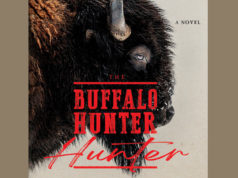How many literary references does it take to screw in a light bulb?
That’s easy. Less than it takes to screw up a book review.
The main character, Max, is very Yossarian, and local author M.R. Koch’s debut novel, Halfway to Impossible, is deceptively Orrwellian.
No, I did not misspell “Orrwellian.” Not exactly. Because Orr is Yossarian’s tentmate in Joseph Heller’s 1961 satirical war novel Catch 22. “Orwellian” chiefly refers to George Orwell’s dystopian masterwork, 1984, but Orwell’s real name was Eric Blair. “Orrwellian” is my convenient upgrade to “Orwellian,” a categorization conjured in my mind after an inspired reading of Halfway to Impossible.
“Orrwellian,” in Heller’s words, is descriptive of “a warm-hearted, simple-minded gnome.” A gnome is a diminutive, mythological being introduced by Paracelsus in the 16th century in tales of Renaissance magic and alchemy. In any circle of friends, the Orrs are the true believers, and, if you’re lucky, the heedless strivers or dreamers. Heller’s Orr is a WWII American B-25 pilot who prostitutes beat over the head with a shoe and whose bombers crash repeatedly — but he insists his bombardier tentmate Yossarian should fly with him. Yossarian thinks Orr’s crazy, while he — Yossarian — simultaneously feigns craziness to escape increased bombing missions and return home.
M.R. Koch’s Orr is Max’s friend, Sam. Sam has latched onto a transient, effervescent young woman that he beats himself over the head about and keeps crashing New Orleans to consummate his fascination with.
Though Halfway to Impossible never mentions Catch 22, it does mention Hemingway’s The Sun Also Rises on a few occasions, and at the halfway point to impossible, Max meets his own version of Hemingway’s Brett Ashley — though he treats her with less conclusive fatalism than Hem.
Hemingway’s Jake Barnes may not be able to consummate or elevate the necessary appendage to consummate his romantic relations due to a war wound, but the titular sentiment is sound. The sun also (or still) rises, and life goes on.
At the end of Catch 22, Orr escapes the war after another crash-landing in the Mediterranean and a paddle to freedom in a life raft. He’d had a fantastical plan all along, and Yossarian’s skepticism costs him his escape. But Max and Sam are not characters from a time when Americans had faith in “good” wars or even the nation they fought for. As a more assertive, somewhat Yossarianesque character in Chuck Palahniuk’s Fight Club notes, “We have no Great War. No Great Depression. Our Great War’s a spiritual war. Our Great Depression is our lives. We’ve all been raised on television to believe that one day we’d all be millionaires, and movie gods, and rock stars. But we won’t. And we’re slowly learning that fact.”
This is the backdrop of the landscape that Koch’s Max and Sam navigate. The sun still rises, but it offers much less luster for the male and female traversers of the aughts than it offered for their grand- and great-grandparents, making too many sunrises seem little more than lost causes. Koch flips Heller, as his Orr succumbs to gnomic naivete, and his Yossarian emerges not completely Orrwellian but hopeful, and more realistic, in Orwellian times.
Koch’s prose is richly descriptive and features refreshing lexiconic challenges in places, drawing you into a world where young men still raise their lances against the normal obstructions that deny their paths to Shangri La. The development and conveyance of the female characters, especially Caroline, Brett and Electra, are all compelling, insightful, and familiar. Koch is a keen observer, and if you were ever young and worldly, or even young and half-sober in a bar or nightclub in or around the dawn of the 21st century, you will probably recognize some of these people and feel nostalgic. There were Hemingway and Helleresque characters trying to make and understand their way. The nonlinear tale features succinct verisimilitude and ends like an ode to the humanity of American youth as they resign themselves to a dubious adulthood, punctuated by gain and loss, and loss and gain — the see-saw outlook of our present reality. But Koch’s Max is wiser and still tilting. I think Hem, Heller, and Blair would all be proud.
If my own existence and experiences didn’t resemble those of some of the characters in Halfway to Impossible in so many engaging ways, I’d clamor for a sequel, but I wonder if I’m not living it already.
It’s certainly pretty to think so.
Halfway to Impossible by M.R. Koch
REaDLips Press
$13.99
215 pps.











